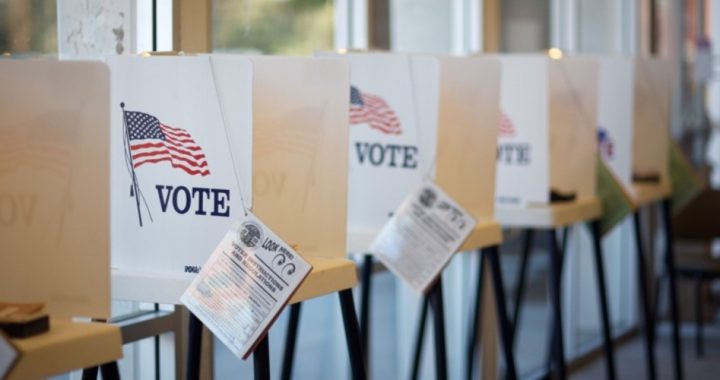
How severe is vote fraud in America? Some critics say that electoral sleight-of-hand has resulted in stolen elections, while others shrug the problem off as negligible at worst. But a new analysis of 2016 primary voting trends indicates, many analysts insist, that ballot fraud’s magnitude may be quite staggering.
A big story this election cycle has been the enthusiasm gap, with Republican turnout up markedly and Democrat turnout down relative to the Obama-fired, McCain-tired 2008 election. But what’s raising eyebrows is that the Democrat decline is not consistent:
It is 227 percent greater in states with new voter-ID laws than in those without new voter-ID laws.
As the Huffington Post reported last week:
As voting rights advocates predicted loud and often, new voter ID laws seem to be hitting Democrats harder than Republicans.
GOP voter turnout in this year’s presidential race is up 62 percent relative to 2008, the last time both parties had open contests. But Democratic voter turnout is down by 29 percent across all the primary and caucus states that have voted so far. In all but two states, fewer Democrats turned out to vote in 2016 than did in 2008.
Evidence suggests that new voting restrictions are at least a contributing factor.
Eight out of the 16 states that have held primaries or caucuses so far [as of March 3, when the Post piece was published] have implemented new voter ID or other restrictive voting laws since 2010. Democratic turnout has dropped 37 percent overall in those eight states, but just 13 percent in the states that didn’t enact new voter restrictions. To put it another way, Democratic voter turnout was 285 percent worse in states with new voter ID laws.
Note that the Post’s calculations appear incorrect. The average drop in Democrat participation in the eight states with new voter-ID laws is, according to my calculations, 29 percent, not 37 percent. For the states without them the Post was close enough: The precise figure is 12.9 percent. This means Democrat voter turnout was 227 percent worse in states with new voter ID laws, not 285 percent.
Not surprisingly, the left-wing Post’s thesis is that these voter-ID laws are “suppressing” the minority vote (which skews Democrat by wide margins) because, supposedly, minorities aren’t as capable of obtaining identification. But American Thinker’s Russ Vaughn has a different take, writing, “If the Democrat voter turnout trend continues through the general election to be significantly lower only in those states where voter ID laws have been recently enacted, … [w]hat will then become evident is that the Democratic Party has been engaged in voter fraud on a broad, nationwide scale. An even more disturbing revelation that is sure to arise from all this is that the Democratic Party has most likely encouraged voter fraud in minority communities, where criminal evidence of such fraud is most commonly found.”
Having said all this, the Post’s presentation is a bit tendentious. First, the site is separating states based on whether they’ve enacted voter-ID laws since 2010, ignoring that three out of the eight states on its “States Without New Voting Restrictions Since 2010” list (SWoL) also have operative voter-ID laws — originating prior to 2010. They are Alaska, Colorado, and Oklahoma.
In addition, Nevada had the second-largest decline in Democrat turnout (28.6 percent) of any state on the SWoL — registering a greater decline than half the states on the “States With New Voting Restrictions Since 2010” list (SWL) — but has no voter-ID law. Likewise, Arkansas had the largest decline (29.1 percent) on the SWoL, being greater than that of five of the eight on the SWL, despite having a voter-ID law that was ruled unconstitutional and is now toothless. Then there’s Iowa: It’s on the SWL, with a Democrat turnout decline of 27.5 percent. Yet with the state also being 91-percent white, well above the national average, it’s hard to imagine that the phenomenon is due to “suppression of the minority vote.”
The reality is that there’s a more mundane explanation for the majority of the decrease in Democrat turnout on the SWL. Consider the list, ranked from highest to lowest Democrat-turnout decline: Texas (50.3 percent), Tennessee (40.6), South Carolina (30.6), Georgia (28.8), Iowa (27.5), Alabama (25.9), Virginia (20.5), New Hampshire (11.7). Note that five of the eight — and all of the top four — went for the GOP in 2012. In contrast, five out of the seven on the SWoL that have already held Democrat primaries this year went for the Democrats in 2012.
Conclusion? The red states generally had the greatest decline in Democrat turnout, and this makes sense. After all, such states have large numbers of relatively conservative Democrats, and how inspired to vote will these people be by a member of the notoriously liberal, kleptocratic Clinton machine and an avowed socialist from the Northeast? If Hillary Clinton and Bernie Sanders are dampening the enthusiasm of blue-state Democrats, just imagine the reaction of Blue Dog Democrats.
This thesis is further buttressed by taking the states that have had Democrat primaries and, instead of dividing them into the SWL and SWoL categories, dividing them based on the 2012 vote. This gives us the following red states:
• Texas (-50.3 percent)
• Tennessee (-40.6)
• South Carolina (-30.6)
• Arkansas (-29.1)
• Georgia (-28.8)
• Alabama (-25.9)
• Oklahoma (-19.6)
And the following blue states:
• Nevada (-28.6)
• Iowa (-27.5)
• Virginia (-20.5)
• Vermont (-12.4)
• New Hampshire (-11.7)
• Massachusetts (-4.3)
• Minnesota (+0.4)
• Colorado (+3.3)
The average decline in Democrat participation in the red states is 32.1 percent; in the blue states, it’s 12.7 percent. Note again that the SWL figure is 29.5 percent, and the SWoL figure is 12.9 percent. So as mentioned earlier, using Huffpo’s tendentious standard of new voter-ID laws only since 2010, the Democrat turnout was 227 percent worse in states with new voter-ID laws.
But it was 253 percent worse in the red states than in the blue ones.
This again indicates that the critical factor in these turnout disparities is not differences in voter-ID laws, but differences in Democrat voters. It should also be noted that conservative states, with these more conservative Democrats, are more likely to enact voter-ID laws in the first place, creating a correlation appearing as causation.
This doesn’t mean the voter-ID laws have no effect. Huffpo also reports on a university study — analyzing the effects of all such laws (not just recent ones) — determining “that Democratic voter turnout dropped by 8.8 percent while Republican turnout fell by only 3.6 percent” after the enactment of the laws.
Now Huffpo also states that the Democrat participation decline “was most apparent among minority voters,” and this is no doubt true. This isn’t due to voter “suppression,” however. And voter-ID laws aren’t “restrictions,” as Huffpo puts it, unless one considers restricting the voting franchise to living citizens voting once — and excluding illegals, the dead, and double-voters — some kind of unjust “suppression.” Do note that the government requires ID for virtually everything, from obtaining benefits (Social Security, food stamps) to visiting the White House. So it’s a little odd that applying the same requirement to voting is portrayed as an unfair burden.
The truth here is plain: As Vaughn pointed out, what’s being suppressed is not minority voting — but vote fraud in minority communities.
And that is where most of it occurs. I explained why in 2005, reporting on information given to me by a local Washington, D.C., community leader, who, as he put it, had “done some computer work for several candidates over the years in DC.” This man, who I dubbed “Deep Vote,” had also conducted his own study of vote fraud in the inner-city. As I related at the time:
It is transiency which provides Democrat political operatives with the most golden of opportunities to steal votes. In depressed urban areas an inordinate number of residents move in and out every year, with some taking up residence for only a brief time.
… A high rate of transiency inevitably leaves a large number of people who no longer live in an area on the voter rolls. The local authorities, says Deep Vote, “are always somewhat late on removing non-residents.” All the Democrat operatives need do then is ascertain who these people are and vote for them. Deep Vote explains the mechanics of this process.
You can read the rest here.
Add to the above the fact that big cities offer anonymity (so how would a poll worker know who’s who without ID?) and are plagued by criminality of all kinds, and it’s not surprising that the crime known as vote fraud is rampant there.
And what is the magnitude? While the nature of crime makes that impossible to know precisely, a 2014 report by the Pew Center found “that more than 1.8 million dead people are currently registered to vote. And 24 million registrations are either invalid or inaccurate,” as NPR wrote at the time. So vote-fraud opportunities abound.
Of course, there really shouldn’t even be a debate here. In a nation where ID is needed for virtually everything, there could only be one reason for claiming that requiring it to vote is oppressive. And it has nothing to do with concern for the “integrity” of the electoral process.



